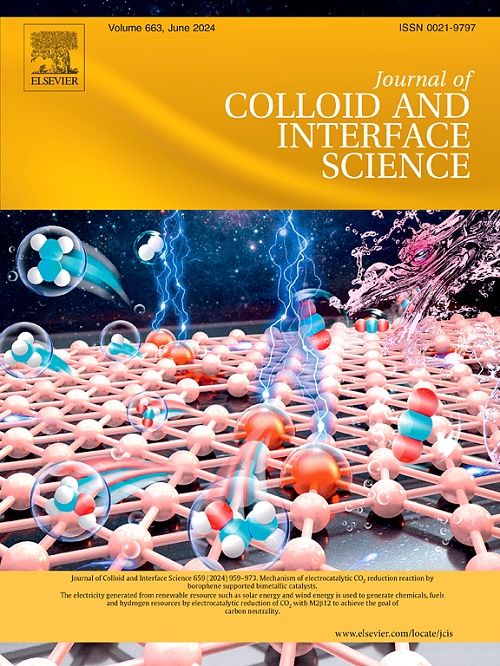Electric field derived from NiCo2S4-MoS2 n-n heterojunction promoted electrocatalytic methanol oxidation assisted energy-saving hydrogen production
IF 9.4
1区 化学
Q1 CHEMISTRY, PHYSICAL
引用次数: 0
Abstract
Water electrolysis coupling methanol oxidation is an energy-efficient hydrogen generation technology, while obtaining high-value formic acid, however, superior catalysts are often required to achieve efficient hydrogen production. Herein, the n-n heterojunction (NiCo2S4-MoS2) composed of NiCo2S4 nanoparticles uniformly dispersed on ultrathin MoS2 nanosheet arrays has been prepared through hydrothermal-pyrolysis process. At a current density (j) of 10 mA cm−2, the potentials of NiCo2S4-MoS2 for methanol oxidation reaction (MOR) and hydrogen evolution reaction (HER) are respectively 1.282 V and −36 mV with very high selectivity for formic acid. Importantly, under the same conditions, by using the n-n heterojunction as electrodes, the voltage (1.355 V) of the methanol electrolysis is 216 mV lower than that of the water electrolysis. Meanwhile, at higher j of 100 mA cm−2, the voltage of the methanol electrolysis is only 6.8 % higher than the original after 150 h chronopotentiometry (CP) test. The outstanding performance of NiCo2S4-MoS2 exceeds that previously reported in most literature, which is primarily attributed to the fact that the built-in electric field (BEF) derived from the Fermi level (EF) difference between NiCo2S4 and MoS2, accelerates the charge transfer, optimizes the electronic structure of the heterojunctions, and thus improving the electrical conductivity. Furthermore, MoS2 nanosheet arrays with large specific surface area provide a fast charge/mass transfer channel, uniformly dispersed NiCo2S4 and defect sites produce abundant active sites. And the superior hydrophilicity and aerophobicity of the heterojunction surface accelerate the reaction kinetics. Finally, density functional theory (DFT) calculations show that the formation of the heterojunction optimizes the electron density and d-band center of composites, thus enhancing H* adsorption and CH3OH dehydrogenation kinetics.

NiCo2S4-MoS2 n-n异质结产生的电场促进了电催化甲醇氧化辅助节能制氢
水电解偶联甲醇氧化是一种节能制氢技术,虽然可以获得高值甲酸,但要实现高效制氢往往需要优良的催化剂。本文通过水热热解法制备了NiCo2S4纳米颗粒均匀分散在超薄MoS2纳米片阵列上的n-n异质结(NiCo2S4-MoS2)。在10 mA cm−2的电流密度(j)下,NiCo2S4-MoS2的甲醇氧化反应(MOR)和析氢反应(HER)电位分别为1.282 V和- 36 mV,对甲酸具有很高的选择性。重要的是,在相同条件下,采用n-n异质结作为电极,甲醇电解的电压(1.355 V)比水电解的电压低216 mV。同时,在更高的j为100 mA cm−2时,经过150 h的时间电位测定(CP)测试,甲醇电解电压仅比原电压高6.8%。NiCo2S4-MoS2的优异性能超过了之前大多数文献的报道,这主要是由于NiCo2S4与MoS2之间的费米能级(EF)差产生的内置电场(BEF)加速了电荷转移,优化了异质结的电子结构,从而提高了电导率。此外,具有大比表面积的MoS2纳米片阵列提供了快速的电荷/传质通道,均匀分散的NiCo2S4和缺陷位点产生了丰富的活性位点。异质结表面优越的亲水性和疏气性加速了反应动力学。最后,密度泛函理论(DFT)计算表明,异质结的形成优化了复合材料的电子密度和d带中心,从而增强了H*吸附和CH3OH脱氢动力学。
本文章由计算机程序翻译,如有差异,请以英文原文为准。
求助全文
约1分钟内获得全文
求助全文
来源期刊
CiteScore
16.10
自引率
7.10%
发文量
2568
审稿时长
2 months
期刊介绍:
The Journal of Colloid and Interface Science publishes original research findings on the fundamental principles of colloid and interface science, as well as innovative applications in various fields. The criteria for publication include impact, quality, novelty, and originality.
Emphasis:
The journal emphasizes fundamental scientific innovation within the following categories:
A.Colloidal Materials and Nanomaterials
B.Soft Colloidal and Self-Assembly Systems
C.Adsorption, Catalysis, and Electrochemistry
D.Interfacial Processes, Capillarity, and Wetting
E.Biomaterials and Nanomedicine
F.Energy Conversion and Storage, and Environmental Technologies

 求助内容:
求助内容: 应助结果提醒方式:
应助结果提醒方式:


